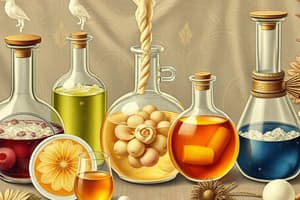Podcast
Questions and Answers
What primarily influences the solubility of a substance?
What primarily influences the solubility of a substance?
- The weight of the solute
- The volume of the solvent
- The temperature and nature of the solute and solvent (correct)
- The color of the solvent
What effect does increasing temperature have on the rate of solvation?
What effect does increasing temperature have on the rate of solvation?
- Decreases the rate of solvation
- Increases the rate of solvation (correct)
- Changes the type of solute that can dissolve
- Has no effect on solvation
What is the effect of stirring a solution on solubility?
What is the effect of stirring a solution on solubility?
- It changes the solute into a gas
- It decreases the concentration
- It keeps particles stationary preventing collisions
- It enhances the rate of solvation (correct)
What does molarity measure?
What does molarity measure?
If a solution becomes less concentrated, what process has occurred?
If a solution becomes less concentrated, what process has occurred?
How would you calculate the molarity of a solution with 0.5 moles of solute in 1.5 L of solution?
How would you calculate the molarity of a solution with 0.5 moles of solute in 1.5 L of solution?
What is the primary reason for breaking a solute into smaller pieces before dissolving it?
What is the primary reason for breaking a solute into smaller pieces before dissolving it?
What distinguishes the first problem from the second in calculating molarity?
What distinguishes the first problem from the second in calculating molarity?
Flashcards
Solution
Solution
A homogeneous mixture where the particles of the solute are evenly distributed throughout the solvent.
Solubility
Solubility
The ability of a solute to dissolve in a solvent.
Tyndall Effect
Tyndall Effect
The scattering of light by particles in a mixture. This effect is used to distinguish between solutions, colloids, and suspensions.
Solvation
Solvation
Signup and view all the flashcards
Concentration
Concentration
Signup and view all the flashcards
Dilution
Dilution
Signup and view all the flashcards
Molarity
Molarity
Signup and view all the flashcards
Calculating Molarity
Calculating Molarity
Signup and view all the flashcards
Study Notes
Mixtures and Pure Substances
- Mixtures are combinations of two or more pure substances
- Homogenous mixtures have uniform composition, components are indistinguishable
- Heterogeneous mixtures have non-uniform composition, components can be distinguished
- Pure substances contain only one type of constituent
Types of Homogenous Mixtures
- Solutions: homogenous mixtures of solute(dissolved) and solvent(doing the dissolving) that do not scatter light
- Colloids: homogenous mixtures that scatter light (Tyndall effect). Particles are larger than in solutions.
- Suspensions: mixtures in which the dispersed particles settle out over time (heterogeneous mixtures) and scatter light
Solubility
- Solubility is the ability of a substance (solute) to dissolve in a given solvent
- Unsaturated solutions: can dissolve more solute at a given temperature
- Saturated solutions: cannot dissolve more solute at a given temperature
- Supersaturated solutions: contain more solute than can be dissolved at a given temperature; unstable
Solvation
- Solvation is the process of dissolving a solute in a solvent
- Solubility depends on the nature of the solute and solvent and the intermolecular forces between them
Factors Affecting Solubility
- Stirring/shaking increases the rate of solvation by moving dissolved particles away from contact surfaces
- Increasing surface area increases the rate of solvation by creating more collision surfaces
- Temperature increases the rate of solvation
Concentration
- Concentration measures the amount of solute dissolved in a given amount of solvent or solution
- Dilutions decrease concentration by adding more solvent
- Molarity (M) is the number of moles of solute per liter of solution (M = moles of solute / Liters of solution)
Calculating Molarity
- Use the formula M = moles of solute / Liters of solution
- Include values with units
- Report the answer with correct significant digits
Solubility Curves
- Solubility curves show the relationship between solubility and temperature
- Two types of problems
- Mass of water is 100 grams; read directly from the graph
- Different mass or volume of solvent; read from graph and then use calculations
Studying That Suits You
Use AI to generate personalized quizzes and flashcards to suit your learning preferences.




